International Journal of Information Technology and Computer Science @ijitcs
Статьи журнала - International Journal of Information Technology and Computer Science
Все статьи: 1254
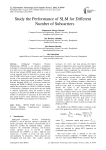
Study the Performance of SLM for Different Number of Subcarriers
Статья научная
Orthogonal Frequency Division Multiplexing (OFDM) is an attractive modulation technique for transmitting large amounts of digital data over radio waves. One major disadvantage of OFDM is that the time domain OFDM signal which is a sum of several sinusoids leads to high peak to average power ratio (PAPR) which leads to power inefficiency in RF section of the transmitter and increased complexity in the analog to digital and digital to analog Converter. Selected mapping (SLM) is a well-known method for reducing the PAPR in OFDM. In this paper, we have studied the performance of SLM for Different Number of Subcarriers. Simulation result shows that the PAPR is reduced significantly when the number of phase sequences is increased and PAPR is increased when the number of subcarriers is increased. It also shows that data speed increases when subcarriers increase where N-point IFFT/FFT circuit depends on N-subcarriers.
Бесплатно
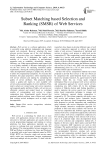
Subset matching based selection and ranking (SMSR) of web services
Статья научная
Web service is a software application, which is accessible using platform independent and language neutral web protocols. However, selecting the most relevant services became one of the vital challenges. Quality of services plays very important role in web service selection, as it determines the quality and usability of a service, including its non-functional properties such as scalability, accessibility, integrity, efficiency, etc. When agent application send request with a set of quality attributes, it becomes challenging to find out the best service for satisfying maximum quality requirements. Among the existing approaches, the single value decomposition technique is popular one; however, it suffers for computational complexity. To overcome this limitation, this paper proposed a subset matching based web service selection and ranking by considering the quality of service attributes. This proposed method creates a quality-web matrix to store available web services and associated quality of service attributes. Then, matrix subsets are created using web service repository and requested quality attributes. Finally, web services are efficiently selected and ranked based on calculated weights of corresponding web services to reduce composition time. Experimental results showed that proposed method performs more efficient and scalable than existing several techniques such as single value decomposition.
Бесплатно
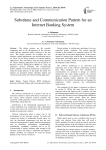
Substitute and Communication Pattern for an Internet Banking System
Статья научная
The design patterns are the reusable component used in the development of the software, which delivers enhanced quality software to the end users. The design patterns are available for user interface, mobile applications, text classification and so on. There are no design patterns for internet banking applications. This motivated to mine the design patterns for internet banking application from the document of Business Process Management (BPM) by using the qualitative research technique. The nonfunctional quality attribute of software architecture is enhanced by using the design patterns. In this paper the mined two patterns are presented namely substitute pattern and communication pattern for internet banking application.
Бесплатно
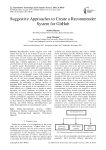
Suggestive Approaches to Create a Recommender System for GitHub
Статья научная
Recommender system suggests users with options that may be of use to them or may be of their interest or liking. These days recommender systems are used widely on most systems and especially on those which are connected to World Wide Web, it may be a mobile app, a desktop application, or a website. Most advertisements on these systems are focused on targeting a specific group. Recommender systems provide a solution to such a scenario where the recommendations need to be targeted based on a user profile. Almost all commercial, collaborative or even social networking websites rely on recommender systems. In this paper, we specifically focus on GitHub, a source code hosting site and one of the most popular platforms for online collaborative coding and sharing. GitHub offers an opportunity for researchers to perform analysis by providing REST-based APIs for downloading its data. GitHub hosts a vast amount of user repositories so it is quite difficult for a GitHub user to decide to which repository she should contribute on GitHub. So, our paper aims to review different approaches that can be used for creating a recommender system for GitHub, to provide personalized suggestions to GitHub users to which repositories they should contribute. In this paper, we have discussed collaborative filtering, content-based filtering, and hybrid filtering, knowledge-based and utility-based approaches of a recommender system.
Бесплатно
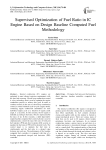
Статья научная
Internal combustion (IC) engines are optimized to meet exhaust emission requirements with the best fuel economy. Closed loop combustion control is a key technology that is used to optimize the engine combustion process to achieve this goal. In order to conduct research in the area of closed loop combustion control, a control oriented cycle-to-cycle engine model, containing engine combustion information for each individual engine cycle as a function of engine crank angle, is a necessity. In this research, the IC engine is modeled according to fuel ratio, which is represented by the mass of air. In this research, a multi-input-multi-output baseline computed fuel control scheme is used to simultaneously control the mass flow rate of both port fuel injection (PFI) and direct injection (DI) systems to regulate the fuel ratio of PFI to DI to desired levels. The control target is to maintain the fuel ratio at stoichiometry and the fuel ratio to a desired value between zero and one. The performance of the baseline computed fuel controller is compared with that of a baseline proportional, integral, and derivative (PID) controller.
Бесплатно
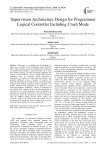
Supervision Architecture Design for Programmer Logical Controller Including Crash Mode
Статья научная
This paper is a contribution for development of a high level of security for the Programmer Logic Controller (PLC). Many industrial adopt the redundant PLC architecture (or Standby PLC) designed to replace the failed (out of order) PLC without stopping associated automated equipments. We propose a formal method to choose a Standby PLC based on probability study, by comparing normal functioning to misbehavior one leading to residue generation process. Any generated difference reveals a presence of anomaly. The proposed method begins by listing all PLC components failures leading to their stopping according to failures criticalities. Two models; functional and dysfunctional are obtained by using formal specifications. Probability’s calculus of dysfunction of each Standby PLC is obtained by the sum of the probabilities of dysfunction of its critical components. These probabilities are allocated each transition which leads to the dysfunction in the dysfunctional model. The dysfunctional model is obtained by using the FMECA method (Failure Modes, Effects and Criticality Analysis). We shall see that this global vision of functioning of the whole PLC leads to a higher level of security where the chosen Standby PLC works continuously.
Бесплатно
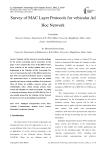
Survey of MAC Layer Protocols for vehicular Ad Hoc Network
Статья научная
Vehicular Ad Hoc Network is currently challenge for the wireless networking and its researchers. In this paper we have proposed the survey of the different MAC Layer protocols of the wireless medium those can be implemented in the Vehicular Ad Hoc Networking. The survey is based upon the study of the different protocol on their MAC level and its performance factors is evaluated. The performance factor is extracted from the studied materials and current working conditions of the protocols. These all factors are mobility, accuracy, privacy and confidentiality, safety critical message priority, delay control and suitability on vehicle and roadside. According to analyzed performance factor the IEEE 802.11p Wave is most suitable protocol for the Vehicular Ad Hoc Network but it does not cover up all conditional requirements.
Бесплатно
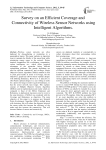
Статья научная
Wireless sensor networks are often deployed for data-gathering or monitoring in a geographical region. This paper explains an important issue to maintain the fidelity of the sensed data while minimizing energy usage in the network. Nature inspired computation like evolutionary computation, swarm intelligence etc., which offers practical advantages to the researcher facing difficult optimization problems. The genetic algorithms are used for efficient connectivity and coverage. Single Objective Genetic Algorithms (SOGA) method is used to yield good results in terms of Coverage, but the objective’s graph had shown Pareto optimal designs with differing Endurance. However it is attractive to offer Pareto optimal designs to a user willing to settle for a poorer Coverage in order to gain in Endurance, so that the sensor network lasts longer. This explains concept of Multiple Objective Genetic Algorithm (MOGA) and its implementation and results which are compared to those of the SOGA. Endurance and Robustness to deployment inaccuracy tend to work in the same direction. A MOGA was conducted with the Coverage and Robustness as objectives. The main objective of this paper is to propose new Strength Perito Evolutionary Algorithm (SPEA) method along with clustering, this will reduce the distances between the sensor nodes that increase the efficiency of the nodes and also increase the connectivity. This will increase lifetime of sensors and connectivity.
Бесплатно
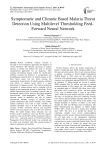
Статья научная
Recent worldwide medical research is focusing on new intelligence approaches for diagnosis of various infections. The sporadic occurrence of malaria diseases in human has pushed the need to develop computational approaches for its diagnoses. Most existing conventional malaria models for classification problems examine the dynamics of asymptomatic and morphological characteristics of malaria parasite in the thick blood smear, but this study examine the symptomatic characteristics of malaria parasite combined with effects of climatic factor which is a great determinant of malaria severity. The need to predict the occurrence of malaria disease and its outbreak will be helpful to take appropriate actions by individuals, World Health Organizations and Government Agencies and its devastating impact will be reduced. This paper proposed Feed-Forward Back-Propagation (FF_BP) Neural Network model to determine the rate of malaria transmission. Monthly averages of climatic factors; rainfall, temperature and relative humidity with monthly malaria incidences were used as input variables. An optimum threshold value of 0.7100 with classification accuracy 87.56%, sensitivity 96.67% and specificity 76.67% and mean square error of 0.100 were achieved. While, the model malaria threat detection rate was 87.56%, positive predictive value was 89.23%, negative predictive value was 92.00% and the standard deviation is 2.533. The statistical analysis of Feed-Forward Back-Propagation Neural Network model was conducted and its results were compared with other existing models to check its robustness and viability.
Бесплатно
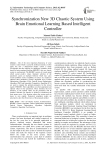
Synchronization New 3D Chaotic System Using Brain Emotional Learning Based Intelligent Controller
Статья научная
One of the most important phenomena of some systems is chaos which is caused by nonlinear dynamics. In this paper, the new 3 dimensional chaotic system is firstly investigated and then utilizing an intelligent controller which based on brain emotional learning (BELBIC), this new chaotic system is synchronized. The BELBIC consists of reward signal which accept positive values. Improper selection of the parameters causes an improper behavior which may cause serious problems such as instability of system. It is needed to optimize these parameters. Genetic Algorithm (GA), Cuckoo Optimization Algorithm (COA), Particle Swarm Optimization Algorithm (PSO) and Imperialist Competitive Algorithm (ICA) are used to compute the optimal parameters for the reward signal of BELBIC. These algorithms can select appropriate and optimal values for the parameters. These minimize the Cost Function, so the optimal values for the parameters will be founded. Selected cost function is defined to minimizing the least square errors. Cost function enforce the system errors to decay to zero rapidly. Numerical simulation results are presented to show the effectiveness of the proposed method.
Бесплатно
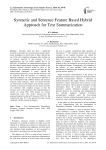
Syntactic and Sentence Feature Based Hybrid Approach for Text Summarization
Статья научная
Recently, there has been a significant research in automatic text summarization using feature-based techniques in which most of them utilized any one of the soft computing techniques. But, making use of syntactic structure of the sentences for text summarization has not widely applied due to its difficulty of handling it in summarization process. On the other hand, feature-based technique available in the literature showed efficient results in most of the techniques. So, combining syntactic structure into the feature-based techniques is surely smooth the summarization process in a way that the efficiency can be achieved. With the intention of combining two different techniques, we have presented an approach of text summarization that combines feature and syntactic structure of the sentences. Here, two neural networks are trained based on the feature score and the syntactic structure of sentences. Finally, the two neural networks are combined with weighted average to find the sentence score of the sentences. The experimentation is carried out using DUC 2002 dataset for various compression ratios. The results showed that the proposed approach achieved F-measure of 80% for the compression ratio 50 % that proved the better results compared with the existing techniques.
Бесплатно
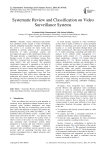
Systematic Review and Classification on Video Surveillance Systems
Статья научная
Recently, various conferences and journals have published articles related to Video Surveillance Systems, indicating researchers’ attention. The goal of this review is to examine the latest works were published in journals, propose a new classification framework of video surveillance systems and investigate each aspect of this classification framework. This paper provides a comprehensive and systematic literature review of video surveillance systems from 2010-2011, extracted from six online digital libraries using article’s title and keyword. The proposed classification framework is expanded on the basis of architecture of video surveillance systems, which is composed of six layers: Concept and Foundation Layer, Network Infrastructure Layer, Processing Layer, Communication Layer, Application Layer, and User Interaction Layer. This review shows, although many publication and research focus on real-time aspect of the challenge, only few researches have investigated the deployment of extracted and retrieved information for forensic video surveillance.
Бесплатно
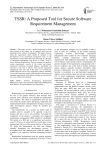
TSSR: A Proposed Tool for Secure Software Requirement Management
Статья научная
This paper provides a unified framework in which entire design of the project can be captured right from the beginning of the software development. This paper discusses about the requirements which should be included in the development of the requirement management tools. As the requirements, criteria which have been discussed, we introduce a requirement management tool known as TSSR (Tool for Secure Software Requirement). This tool manages risk analysis, system requirements, security of the system and project, users/group restriction, encrypted database, traceability and extension of the tool to interact with external requirement management tools. The aim of this paper is to describe the TSSR framework and its four components: Planner, Modeller, Prover and Documenter which will be helpful in interacting and managing requirements with arbitrary number of external tools for secure software development.
Бесплатно
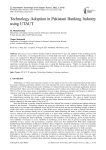
Technology Adoption in Pakistani Banking Industry using UTAUT
Статья научная
The success of any software product could be measured by its uses and adoption of that technology by the end-users. In this study, we investigate the factors on which bank user intents to adopt internet banking in Pakistan. A survey was conducted on Pakistani banking industry customers using the unified theory of acceptance and use of technology (UTAUT) model which explains the intention of bank users to use the banking systems. The four predictors of UTAUT which were facilitating conditions, social influence, effort expectancy and performance expectancy were significant in predicting the intention of bank users to adopt the banking systems. Finally, we discuss the results, restrictions, implications and future recommendations. The findings of the study may help to provide insights into a better approach to promote e-banking acceptance.
Бесплатно
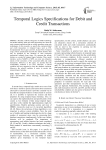
Temporal Logics Specifications for Debit and Credit Transactions
Статья научная
Recently, with the emergence of mobile technology and mobile banking, debit and credit transactions have been the most common transactions that are widely spreading, using such technologies. In this research, we specify the concurrent debit and credit transactions in temporal logics such as CTL (Computational Tree Logic) and LTL (Linear-Time Temporal Logic). These specifications describe the infinite histories that may be produced by the iterations of such concurrent transactions infinitely many times. We represent the infinite histories as a model of temporal logics formulae. Then, model checkers, such as NuSMV or SPIN, can carry out exhaustive checks of the correctness of the concurrent debit and credit transactions. Moreover, in this paper, we presume that the serializability condition is too strict. Therefore, a relaxed condition has been suggested to keep the database consistent. Moreover, the relaxed condition is easier to encode into temporal logics formulae.
Бесплатно
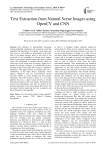
Text extraction from natural scene images using OpenCV and CNN
Статья научная
The influence of exponentially increasing camera-embedded smartphones all around the world has magnified the importance of computer vision tasks, and gives rise to a vast number of opportunities in the field. One of the major research areas in this field is the extraction of text embedded in natural scene images. Natural scene images are the images taken from a camera, where the background is random, and the variety of colors used in the image may be diverse. When text is present in such type of images, it is usually difficult for a machine to detect and extract this text due to a number of parameters. This paper presents a technique that uses a combination of the Open Source Computer Vision Library (OpenCV) and the Convolutional Neural Networks (CNN), to extract English text from images efficiently. The CNN model is based on a two-stage pipeline that uses a single neural network to directly detect the characters in the scene images. It eliminates the unnecessary intermediate steps that are present in the previous approaches to this task making them slower and inaccurate, thereby improving the time complexity and the performance of the algorithm.
Бесплатно
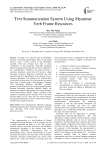
Text summarization system using Myanmar verb frame resources
Статья научная
In today’s era, when the size of information and data is increasing exponentially, there is an upcoming need to create a concise version of the information available. Until now, humans have tried to create “summaries” of the documents. Especially, Myanmar Natural Language Processing does not have computerized text summarization. Therefore, this paper presents a summary generation system that will accept a single document as input in Myanmar. In addition, this work presents analysis on the influence of the semantic roles in summary generation. The proposed text summarization system involves three steps: first, the sentences are parsed using Part of Speech tagger with Myanmar Language Tool Knowledge Resource (ML2KR); secondly, pronouns in the original text are resolved using Myanmar Pronoun Resolution Algorithm (MPAR); thirdly, the sentences are labeled with semantic roles using Myanmar Verb Frame Resource (MVF), finally, extraction of the sentences containing specific semantic roles for the most relevant entities in text. After that, the system abstracts the important information in fewer words from extraction summary from single documents.
Бесплатно
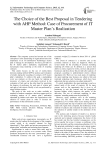
Статья научная
The computer system has become one of the centerpieces in the functioning of organizations hence the importance of an IT (Information Technology) master plan to manage its development. To find a provider for the IT master plan's realization, organizations are increasingly using tendering as the mode of awarding contracts. This article focuses on the use of multi-criteria decision-making method AHP for analysis and evaluation of tenders during the awarding of contracts of IT master plan's realization. To achieve this goal, a painstaking work was realized, on the one hand, for making an inventory of criteria and sub-criteria involved in the evaluation of bids and on the other hand for specifying the degrees of preference for each pair of criteria and each pair of sub-criteria. Finally, a test was performed by using fictitious tenders. The goals of this work are to make available to members of tenders committee a decision support tool for evaluating tenders of IT master plan's realization submitted by bidders and endow the organizations with effective IT master plans in order to increase the performance of their information systems.
Бесплатно
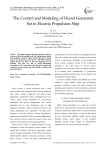
The Control and Modeling of Diesel Generator Set in Electric Propulsion Ship
Статья научная
This paper analyzes the characteristics of power system on electric propulsion ship. The mathematical model and simulation model of diesel engine PID speed control system and synchronous generator’s AVR+PSS excitation control system was built. At last the simulation test of suddenly add load was did in MATLAB/simulink environment. The result shows that the speed control and excitation control system has well stability, rapidity and some robustness.
Бесплатно
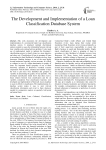
The Development and Implementation of a Loan Classification Database System
Статья научная
This work documents the development and implementation of a commercial bank's loan classification database system. It employed multiple discriminant analysis models to assess the relationship between relevant loan variables and existing bad loan problem. It also made use of mathematical model to replicate the Examiner's classification process to classify loans in a more objective and sober way. Classification of loan is grouping of loans in accordance to their likelihood of ultimate recovery from borrowers. Banking business is one of the most highly levered businesses especially on loan accounts. It is likely to collapse in case of a slight deterioration in quality of loans. Six important factors (propriety of use of funds borrowed; operation of Borrower's overdraft account; cooperation with the Bank, collateral and number of days the loan is past due) were identified and grouped as variables in determining the quality of loan portfolio. The developed classification model shows that there exists a linear relation between loan classification and the six variables considered. Four classification functions were developed and implemented in Microsoft Access database to assist in effective classification. The implementation of a database system makes it easy to store relevant classification information and revert to them whenever needed for comparative analysis on quarterly, half-yearly and annual basis.
Бесплатно

